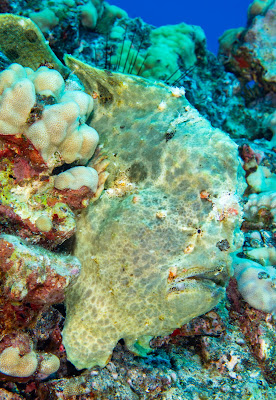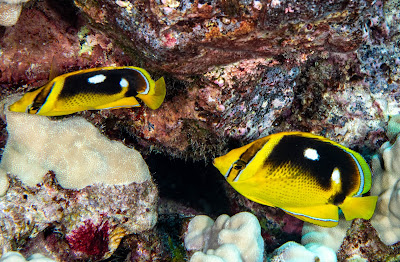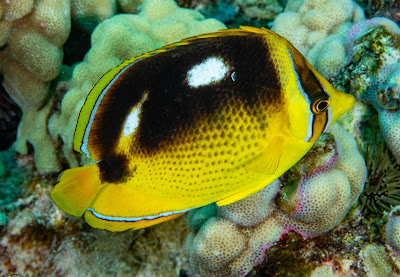Imagine how stoked I was last week when I heard reports of Longfin Anthias surfacing again after a long while. These beautiful little fish are exotic and rare; they live at moderate depth and are very wild and will dive into the lattice-work reef holes at the slightest hint of cameras in the area.
Today we went on purpose to a spot that one of our friends had got one in a video a few days ago. We descended to about 60 feet and slowly angled down the dropoff. Suddenly our guide, Rob, began waving his arm and pointing. That could only mean one thing: That he found one, and he had.
Shortly after, I stumbled onto a fairly rare and extremely cool endemic Black Longnose Butterfly. They only take on this black shade due to the food they eat, while the normal coloration is shown on the one below. But this black longnose is still transitioning; another very cool thing to see.
The antler coral this year seems to be flourishing, after the bleaching events of seven years ago and before, and this is good for fish populations. Lots of fish live in the branches out of danger from predators, and some predators hang out on the branches to use as launching pads. Here's one: Blackside Hawkfish. These are so common but their coloration, posture and contrast with the coral branches makes them very photogenic. And they sit motionless until you swim up to them. I sneak up from below, pop up, shoot, and watch them flit at warp speed to another universe. The Blueline Surgeonfish is one I don't see a lot, so I was happy to find this one not running away from me.
Sometimes another diver motions me over to get a shot that they've just taken. Sometimes I sit there and look hard to see what they were pointing at, but they've already moved on leaving me to just wonder what it is I'm not seeing. This is one of those cases. When that happens I just point the camera in the general area and get off a couple of frames. If there's something there maybe I'll see it in processing. So this tiny Stout Moray was poking out of a hole at the edge of the frame. I zoomed in, glad to have the resolution of my FX sensor, and presented the shot as if I knew what I was doing. #confession
Continuing the theme of getting fish that usually elude me, here is a Bird Wrasse. Not rare, but just hard to shoot. They are so fast and don't like people. I caught this one turning to run away.
Back to shots that are easier to get. Here is a lovely Four Spot Butterfly. They are almost always with their mates, but this one strayed a bit far from it's partner so I only got the one. By the time I get to the Octopus it's either flown the coop or retreated to a hole. This one was giving me stink-eye from its hidey-hole. The Ornate Butterfly is another very common fish, but its coloration is so beautiful that I can't resist. This one was also checking me out before veering off behind a rock outcropping.
It was definitely a day for me to get shots of fish I usually just waste film on since they're so either small, fast or clever. The Ewa Fang Blenny is very small, maybe three inches long and very thin. They are so fast, it's hard to focus on them because of this. I hung out with this one because it stayed in the same area and let me waste about three minutes to get one in-focus shot. Great. Now where has my group of divers gone?
If you stick your head into small caves and under overhangs you might see a Spotted Puffer. And so I did. After that, in the same overhang here was a nice stationary White Mouth Eel. He finally just cracked open his mouth, which makes them look way more menacing for the pictures.






























































